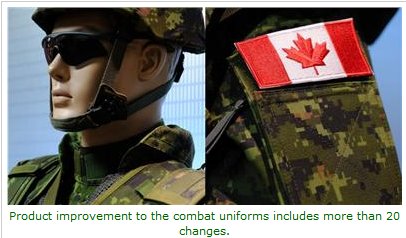A press release describes the changes as the “most radical change since 1970s”:
After 18 months of testing and operational user feedback, production has begun on the Enhanced Combat Uniform for Canadian soldiers.
This product improvement to the combat uniforms includes more than 20 changes which will allow for greater comfort, enhanced protection and greater integration with personal protective equipment, allowing soldiers to more effectively train and perform their duties while deployed.
Some of the major changes are:
- a flexible Mandarin-style collar;
- integrated soft kneepads;
- flat pockets and zippers to avoid pressure points;
- an action-back for increased range of motion; and
- a flexible waist for improved fit.
“The uniforms are better integrated with the rest of the combat equipment while increasing comfort and providing greater wearing options adaptable to the environment a soldier is deployed in,” says Major Stéphane Dufour of the Director of Land Requirements’ Soldier Systems Requirements section. For example, the integrated soft knee pads provide protection in and outside a vehicle. The flat chest pocket style also removes any pressure points while wearing ballistic protection and fragmentation vests.
[. . .]
The uniforms will continue to use the Canadian Disruptive Pattern, known as CADPATTM, which allows soldiers to blend in with the field environment.




